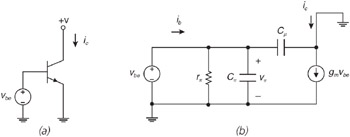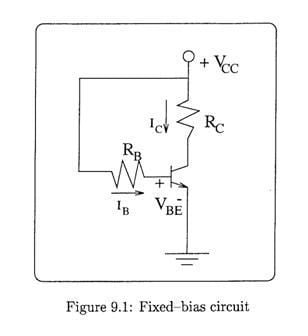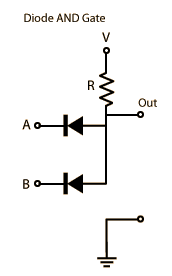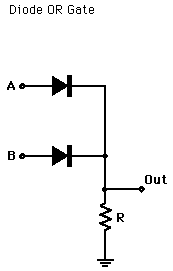Operational amplifiers are circuits as the name suggests which perform various operations on the input signal to generate the output signal.A series of transistors along with suitable values of resistors and capacitors are connected so as to achieve this circuit.Basically an operational amplifier is a high gain dc coupled amplifier.
The operational amplifiers may have application in linear or non-linear devices.
The characteristics of operational amplifiers are discussed first followed by their applications.
The main charateristics which are required to determine the performance of a operational amplifier are described below:
1.Input resistance-It is the resistance that appears between the two differential inputs of the amplifier.Ideally the input impedance should be infinite.In the real amplifier the input resistance is in the order of mega ohms .
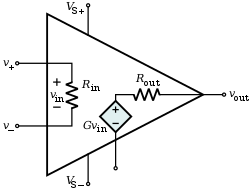 v
v
2.Output impedance :
The output impedance of an amplifier is the impedance which appears in series with the output voltage .Ideally the output impedance of the amplifier should be zero .however the output impedance in a real amplifier is of the order of milli ohms .

3.Input offset voltage:
The difference between the two input terminal voltages is called input offset voltage.Ideally the input offset voltage should be zero,which means the two input terminals should be at the same voltge level.However practicaly a small voltage in mV exists between the terminals.Compensation methods are used to
compensate for this offset voltage.
4.Input bias current:
The value of current entering each of the input terminals of the opamp is called as input bias current.Ideally it should be zero,however it is of the order of nA in the practical opamp.the difference of the bias currents entering the two terminals of the operational amplifier is called as input offset current.
5.Power supply rejection ratio PSRR
The tendency of the operational amplifier to reject the disturbances and the noise signals is called power supply rejection ratio. The PSRR is measured in decibels.
PSRR = Vio/Vcc
the ratio of change in input offset voltage to the supply terminl voltage gives the PSRR.
For IC 741 opamp PSRR is 30microvolt/V.

6.Slew rate:
The rate of change of output voltage with respect to time is called as slew rate.It is usually measured in terms of V per microsecond.The slew rate is an indicator of the speed of response of an operational amplifier. Generally the more the slew rate tthe more sensitive the opamp is.
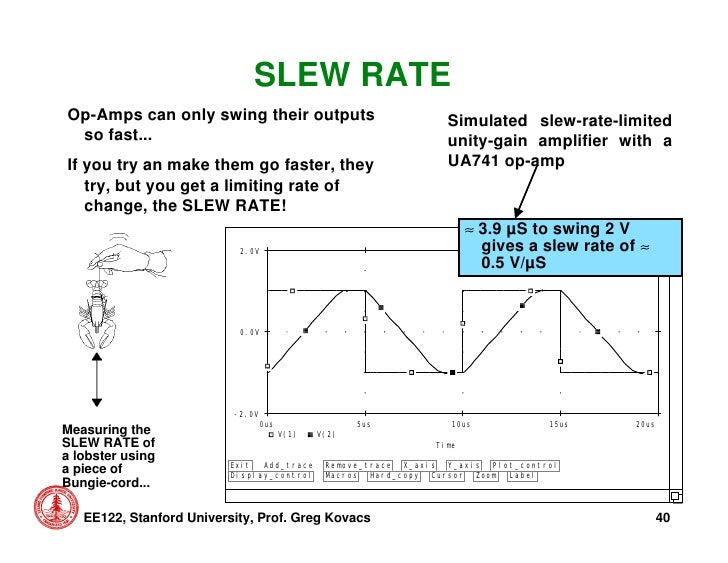
The operational amplifiers may have application in linear or non-linear devices.
The characteristics of operational amplifiers are discussed first followed by their applications.
The main charateristics which are required to determine the performance of a operational amplifier are described below:
1.Input resistance-It is the resistance that appears between the two differential inputs of the amplifier.Ideally the input impedance should be infinite.In the real amplifier the input resistance is in the order of mega ohms .
 v
v2.Output impedance :
The output impedance of an amplifier is the impedance which appears in series with the output voltage .Ideally the output impedance of the amplifier should be zero .however the output impedance in a real amplifier is of the order of milli ohms .
3.Input offset voltage:
The difference between the two input terminal voltages is called input offset voltage.Ideally the input offset voltage should be zero,which means the two input terminals should be at the same voltge level.However practicaly a small voltage in mV exists between the terminals.Compensation methods are used to
compensate for this offset voltage.
4.Input bias current:
The value of current entering each of the input terminals of the opamp is called as input bias current.Ideally it should be zero,however it is of the order of nA in the practical opamp.the difference of the bias currents entering the two terminals of the operational amplifier is called as input offset current.
5.Power supply rejection ratio PSRR
The tendency of the operational amplifier to reject the disturbances and the noise signals is called power supply rejection ratio. The PSRR is measured in decibels.
PSRR = Vio/Vcc
the ratio of change in input offset voltage to the supply terminl voltage gives the PSRR.
For IC 741 opamp PSRR is 30microvolt/V.

6.Slew rate:
The rate of change of output voltage with respect to time is called as slew rate.It is usually measured in terms of V per microsecond.The slew rate is an indicator of the speed of response of an operational amplifier. Generally the more the slew rate tthe more sensitive the opamp is.






